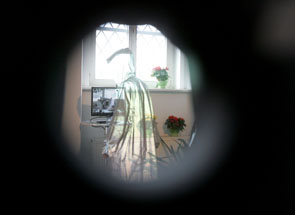|
|
 |
 |

|
 |
 |
Optical Camouflage
Takumi Yoshida, Hideaki Nii, Naoki Kawakami and Susumu Tachi
campus | Tokyo: The Exhibition
Optical Camouflage technology makes that anyone and anything wearing a special cloth seems to be transparent. The cloth is made with a retro-reflective material that reflects light precisely according to the angle of incidence. The fabric consists of retro-reflective material that reflects light precisely in accordance with the angle at which it strikes the material’s surface. Depending on the observers point of view, a projected image blends with the background and the fabric becomes transparent.
Source: rubra
Cross-reference: The right to reprint is reserved for the press; no royalties will be due only with proper copyright attribution.
 download
printversion download
printversion
 back
back
|
 |
|